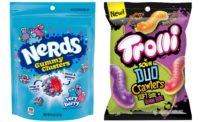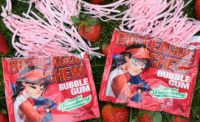Editor’s note: This article is part of our 2020 State of the Confectionery industry. Over the next few weeks we will post category breakdowns, looking at how they have fared over the last year, as well as what the coming year will bring. The introduction to this series will be updated with links to new articles as they are posted.
Established gummy brands and category newcomers continue to drive growth in the non-chocolate chewy candy sector.
And so far, the sector has done well despite the unprecedented impact of COVID-19.
Non-chocolate chewy candy generated $3.9 billion in the year ending June 14, 2020, up 5.2 percent from a year ago, according to IRI, a Chicago-based research firm. Unit sales surpassed 2.26 billion, staying virtually flat (0.4 percent) from the previous year.
And going forward, the global gummy and jellies market is predicted to reach $40 billion at a 5 percent compoung annual growth rate between 2020 and 2024, according to the new report by Market Research Future (MRF).
MRF reports “a growing vegan population, growing awareness about the side effects of eating chocolates, booming candy industry, and increasing consumption over chocolates" are driving category growth. In addition, rising consumer spending, unique packaging, seasonal consumption occasions and the shape, design, texture, sugar content and flavors of gummies and jellies are increasing consumer interest.
North America will dominate the market over the forecast period, MRF says. The United States is the major contributor in the region, accounting for more than 80 percent share of the total revenue alone.
Globally, the Asian Pacific is expected to grow at the fastest pace, thanks to expanded investment by market players, increasing per capita disposable income and rising consumption of confectionery products overall.
So how has the sector fared over the last year?
Mars Wrigley leads the non-chocolate chewy candy category with just under a quarter of the market share. Ferrara Candy Co., maker of Trolli and Black Forest gummies and a variety of chewy candy, followed with nearly 16 percent. Mondelez International, producer of Sour Patch Kids, occupies just over 11 percent, while HARIBO of America, Inc. represents 9 percent.
About a third of the Top 20 non-chocolate chewy brands tracked by IRI are gummy brands. Sour Patch Kids, generating $202.5 million in 52 weeks ending June 14, took the No. 4 spot, while HARIBO Goldbears completed the Top 5 with $195.2 million.
HARIBO, whose Goldbears dollar sales grew by 9.3 percent over the year ending June 14, continues to expand its presence in the United States. The company hopes to celebrate its centennial this year by breaking ground on its first North American production facility in Pleasant Prairie, Wisconsin.
“Producing our treats in the U.S. will enable us to meet growing demand from our consumers for our iconic Goldbears, as well as other products like Twin Snakes and Starmix,” Lauren Triffler, head of corporate communications for HARIBO, told Candy Industry earlier this year. “Our U.S. production facility will help us better serve our customers and consumers with speed and efficiency. It will also help the U.S. consumer base to get to know our brand, who we are and what we believe in.”
HARIBO also launched the limited-edition Passport Mix this year, featuring a combination of popular flavors and shapes from countries including Germany, Spain, France, the UK and the United States, as well as limited-edition Airplane shape.
Ferrara’s Trolli Sour Brite Crawlers pulled in just over $145 million in the year ending June 14, representing a 4.8 percent increase from a year ago. Meanwhile, dollar sales of Mars Wrigley’s Lifesavers gummies stayed virtually flat, generating $123.6 million over the same period.
Albanese Candy rounded out the Top 20 non-chocolate chewy brands tracked by IRI, generating $52.2 million in the year ending June 14. That’s up 33.8 percent from a year ago.
Albanese recently launched the Ultimate 8 Flavor Gummi Bears, which earned the NEXTY 2020 Consumer Choice Award for Food and Beverage. Made with natural colors and flavors, the assortment includes Alphonso Mango, Amity Raspberry, Asian Pear, Black Currant, Blood Orange, Crimson Cranberry, Fuji Apple and Queen Pineapple flavors.
“The Ultimate 8 Flavor Gummi Bears really take flavors to the ultimate level,” Dominique Albanese says. “The variety of unique real fruit flavors give your palate the experience of biting into the actual fruit. From the skin on the outside, to the juicy flesh on the inside, your taste buds will be begging for the next flavor.”
Gummy candy has proved so popular it inspired at least two non-gummy manufacturers to expand into the category within the last year.
In February, SMASHMALLOW maker Sonoma Brands launched low-sugar SMASHGUMMY. It included two varieties: Fresh Picked, featuring Strawberry, Cherry, Orange and Peach flavors; and Pucker Up, a sour mix including Watermelon, Raspberry, Lemon and Green Apple flavors.
"SMASHMALLOW has always been committed to creating permissibly indulgent snacks using the best real and natural ingredients possible, allowing consumers a chance to satisfy that sweet craving in a mindful yet delicious way," says founder Jon Sebastiani. "We are thrilled to bring a new option to our consumers that is in line with our core values. We believe we've created something truly differentiated yet complementary to our existing products and are incredibly excited about this new chapter in the SMASHMALLOW brand story.”
Yowie Group, known for its surprise-inside chocolate eggs, also launched a gummy product for the first time in October 2019. Made with real fruit juice, they’re available in Orange, Grape, Strawberry, Blueberry and Pineapple flavors and are shaped like Yowie characters Rumble, Crag, Boof, Ditty, Squish and Nap.
Yowie Group CMO Cynthia Thayer told Candy Industry these soft-chew gummies were designed to be preschooler friendly and build on the overall popularity of the gummy category.
“What better than gummies? They’re a great treat for kids of many different ages," Thayer says.








